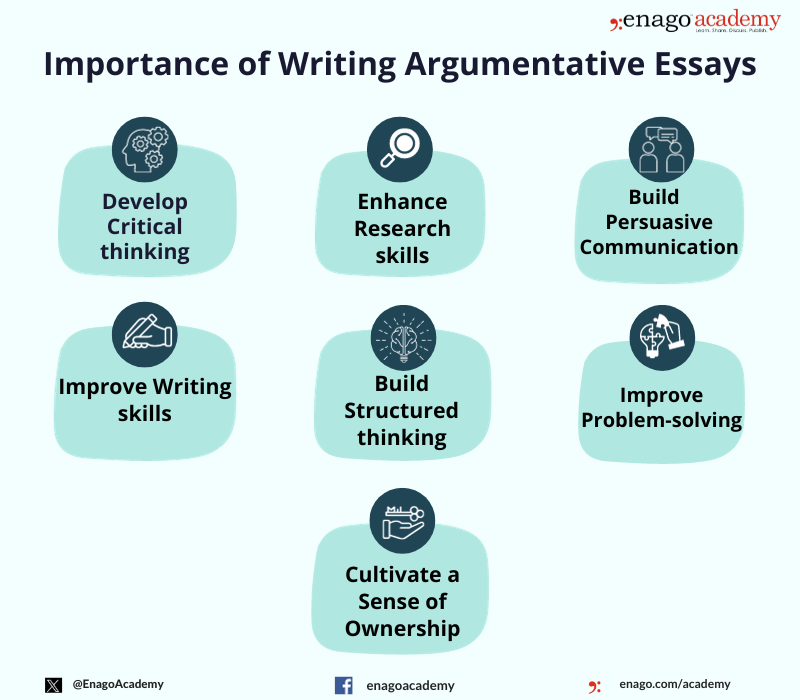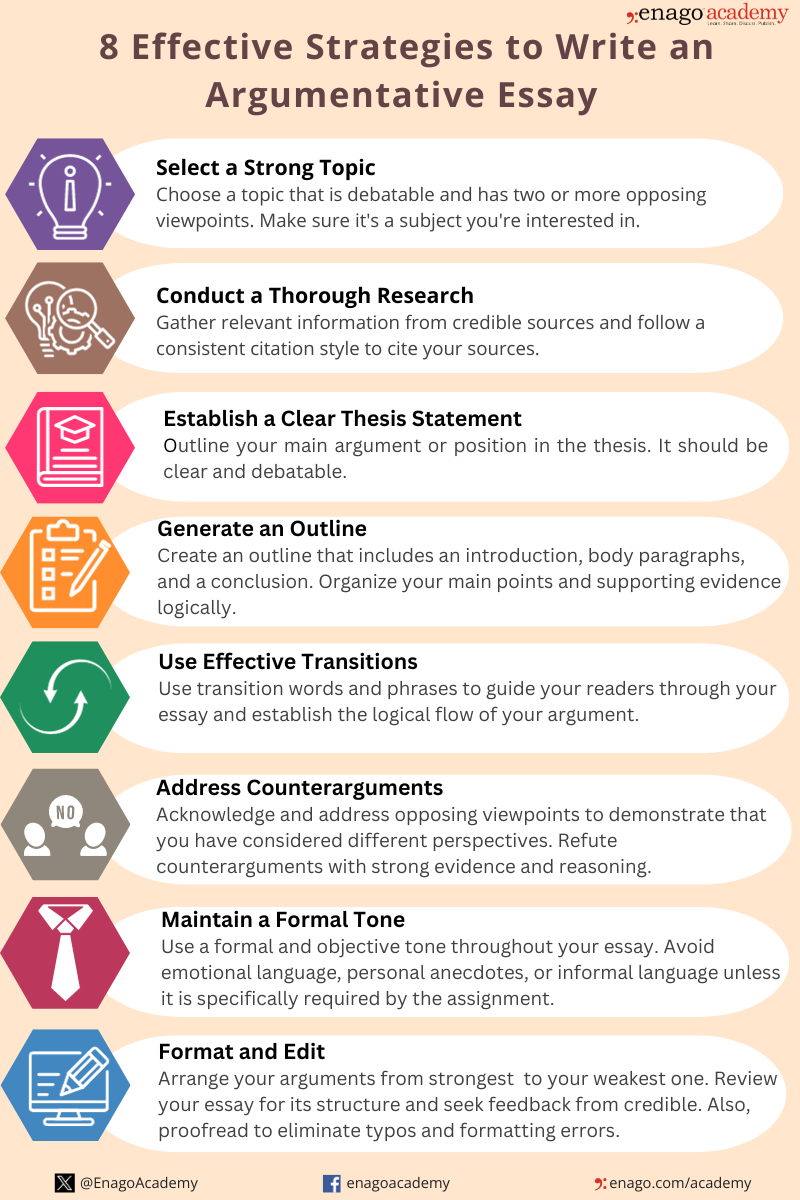

8 Effective Strategies to Write Argumentative Essays
In a bustling university town, there lived a student named Alex. Popular for creativity and wit, one challenge seemed insurmountable for Alex– the dreaded argumentative essay!
One gloomy afternoon, as the rain tapped against the window pane, Alex sat at his cluttered desk, staring at a blank document on the computer screen. The assignment loomed large: a 350-600-word argumentative essay on a topic of their choice . With a sigh, he decided to seek help of mentor, Professor Mitchell, who was known for his passion for writing.
Entering Professor Mitchell’s office was like stepping into a treasure of knowledge. Bookshelves lined every wall, faint aroma of old manuscripts in the air and sticky notes over the wall. Alex took a deep breath and knocked on his door.
“Ah, Alex,” Professor Mitchell greeted with a warm smile. “What brings you here today?”
Alex confessed his struggles with the argumentative essay. After hearing his concerns, Professor Mitchell said, “Ah, the argumentative essay! Don’t worry, Let’s take a look at it together.” As he guided Alex to the corner shelf, Alex asked,
Table of Contents
“What is an Argumentative Essay?”
The professor replied, “An argumentative essay is a type of academic writing that presents a clear argument or a firm position on a contentious issue. Unlike other forms of essays, such as descriptive or narrative essays, these essays require you to take a stance, present evidence, and convince your audience of the validity of your viewpoint with supporting evidence. A well-crafted argumentative essay relies on concrete facts and supporting evidence rather than merely expressing the author’s personal opinions . Furthermore, these essays demand comprehensive research on the chosen topic and typically follows a structured format consisting of three primary sections: an introductory paragraph, three body paragraphs, and a concluding paragraph.”
He continued, “Argumentative essays are written in a wide range of subject areas, reflecting their applicability across disciplines. They are written in different subject areas like literature and philosophy, history, science and technology, political science, psychology, economics and so on.
Alex asked,
“When is an Argumentative Essay Written?”
The professor answered, “Argumentative essays are often assigned in academic settings, but they can also be written for various other purposes, such as editorials, opinion pieces, or blog posts. Some situations to write argumentative essays include:
1. Academic assignments
In school or college, teachers may assign argumentative essays as part of coursework. It help students to develop critical thinking and persuasive writing skills .
2. Debates and discussions
Argumentative essays can serve as the basis for debates or discussions in academic or competitive settings. Moreover, they provide a structured way to present and defend your viewpoint.
3. Opinion pieces
Newspapers, magazines, and online publications often feature opinion pieces that present an argument on a current issue or topic to influence public opinion.
4. Policy proposals
In government and policy-related fields, argumentative essays are used to propose and defend specific policy changes or solutions to societal problems.
5. Persuasive speeches
Before delivering a persuasive speech, it’s common to prepare an argumentative essay as a foundation for your presentation.
Regardless of the context, an argumentative essay should present a clear thesis statement , provide evidence and reasoning to support your position, address counterarguments, and conclude with a compelling summary of your main points. The goal is to persuade readers or listeners to accept your viewpoint or at least consider it seriously.”
Handing over a book, the professor continued, “Take a look on the elements or structure of an argumentative essay.”
Elements of an Argumentative Essay
An argumentative essay comprises five essential components:
Claim in argumentative writing is the central argument or viewpoint that the writer aims to establish and defend throughout the essay. A claim must assert your position on an issue and must be arguable. It can guide the entire argument.
2. Evidence
Evidence must consist of factual information, data, examples, or expert opinions that support the claim. Also, it lends credibility by strengthening the writer’s position.
3. Counterarguments
Presenting a counterclaim demonstrates fairness and awareness of alternative perspectives.
4. Rebuttal
After presenting the counterclaim, the writer refutes it by offering counterarguments or providing evidence that weakens the opposing viewpoint. It shows that the writer has considered multiple perspectives and is prepared to defend their position.
The format of an argumentative essay typically follows the structure to ensure clarity and effectiveness in presenting an argument.
How to Write An Argumentative Essay
Here’s a step-by-step guide on how to write an argumentative essay:
1. Introduction
- Begin with a compelling sentence or question to grab the reader’s attention.
- Provide context for the issue, including relevant facts, statistics, or historical background.
- Provide a concise thesis statement to present your position on the topic.
2. Body Paragraphs (usually three or more)
- Start each paragraph with a clear and focused topic sentence that relates to your thesis statement.
- Furthermore, provide evidence and explain the facts, statistics, examples, expert opinions, and quotations from credible sources that supports your thesis.
- Use transition sentences to smoothly move from one point to the next.
3. Counterargument and Rebuttal
- Acknowledge opposing viewpoints or potential objections to your argument.
- Also, address these counterarguments with evidence and explain why they do not weaken your position.
4. Conclusion
- Restate your thesis statement and summarize the key points you’ve made in the body of the essay.
- Leave the reader with a final thought, call to action, or broader implication related to the topic.
5. Citations and References
- Properly cite all the sources you use in your essay using a consistent citation style.
- Also, include a bibliography or works cited at the end of your essay.
6. Formatting and Style
- Follow any specific formatting guidelines provided by your instructor or institution.
- Use a professional and academic tone in your writing and edit your essay to avoid content, spelling and grammar mistakes .
Remember that the specific requirements for formatting an argumentative essay may vary depending on your instructor’s guidelines or the citation style you’re using (e.g., APA, MLA, Chicago). Always check the assignment instructions or style guide for any additional requirements or variations in formatting.
Did you understand what Prof. Mitchell explained Alex? Check it now!
Fill the Details to Check Your Score

Prof. Mitchell continued, “An argumentative essay can adopt various approaches when dealing with opposing perspectives. It may offer a balanced presentation of both sides, providing equal weight to each, or it may advocate more strongly for one side while still acknowledging the existence of opposing views.” As Alex listened carefully to the Professor’s thoughts, his eyes fell on a page with examples of argumentative essay.
Example of an Argumentative Essay
Alex picked the book and read the example. It helped him to understand the concept. Furthermore, he could now connect better to the elements and steps of the essay which Prof. Mitchell had mentioned earlier. Aren’t you keen to know how an argumentative essay should be like? Here is an example of a well-crafted argumentative essay , which was read by Alex. After Alex finished reading the example, the professor turned the page and continued, “Check this page to know the importance of writing an argumentative essay in developing skills of an individual.”
Importance of an Argumentative Essay

After understanding the benefits, Alex was convinced by the ability of the argumentative essays in advocating one’s beliefs and favor the author’s position. Alex asked,
“How are argumentative essays different from the other types?”
Prof. Mitchell answered, “Argumentative essays differ from other types of essays primarily in their purpose, structure, and approach in presenting information. Unlike expository essays, argumentative essays persuade the reader to adopt a particular point of view or take a specific action on a controversial issue. Furthermore, they differ from descriptive essays by not focusing vividly on describing a topic. Also, they are less engaging through storytelling as compared to the narrative essays.
Alex said, “Given the direct and persuasive nature of argumentative essays, can you suggest some strategies to write an effective argumentative essay?
Turning the pages of the book, Prof. Mitchell replied, “Sure! You can check this infographic to get some tips for writing an argumentative essay.”
Effective Strategies to Write an Argumentative Essay

As days turned into weeks, Alex diligently worked on his essay. He researched, gathered evidence, and refined his thesis. It was a long and challenging journey, filled with countless drafts and revisions.
Finally, the day arrived when Alex submitted their essay. As he clicked the “Submit” button, a sense of accomplishment washed over him. He realized that the argumentative essay, while challenging, had improved his critical thinking and transformed him into a more confident writer. Furthermore, Alex received feedback from his professor, a mix of praise and constructive criticism. It was a humbling experience, a reminder that every journey has its obstacles and opportunities for growth.

Frequently Asked Questions
An argumentative essay can be written as follows- 1. Choose a Topic 2. Research and Collect Evidences 3. Develop a Clear Thesis Statement 4. Outline Your Essay- Introduction, Body Paragraphs and Conclusion 5. Revise and Edit 6. Format and Cite Sources 7. Final Review
One must choose a clear, concise and specific statement as a claim. It must be debatable and establish your position. Avoid using ambiguous or unclear while making a claim. To strengthen your claim, address potential counterarguments or opposing viewpoints. Additionally, use persuasive language and rhetoric to make your claim more compelling
Starting an argument essay effectively is crucial to engage your readers and establish the context for your argument. Here’s how you can start an argument essay are: 1. Begin With an Engaging Hook 2. Provide Background Information 3. Present Your Thesis Statement 4. Briefly Outline Your Main 5. Establish Your Credibility
The key features of an argumentative essay are: 1. Clear and Specific Thesis Statement 2. Credible Evidence 3. Counterarguments 4. Structured Body Paragraph 5. Logical Flow 6. Use of Persuasive Techniques 7. Formal Language
An argumentative essay typically consists of the following main parts or sections: 1. Introduction 2. Body Paragraphs 3. Counterargument and Rebuttal 4. Conclusion 5. References (if applicable)
The main purpose of an argumentative essay is to persuade the reader to accept or agree with a particular viewpoint or position on a controversial or debatable topic. In other words, the primary goal of an argumentative essay is to convince the audience that the author's argument or thesis statement is valid, logical, and well-supported by evidence and reasoning.
Great article! The topic is simplified well! Keep up the good work
Excellent article! provides comprehensive and practical guidance for crafting compelling arguments. The emphasis on thorough research and clear thesis statements is particularly valuable. To further enhance your strategies, consider recommending the use of a counterargument paragraph. Addressing and refuting opposing viewpoints can strengthen your position and show a well-rounded understanding of the topic. Additionally, engaging with a community like ATReads, a writers’ social media, can provide valuable feedback and support from fellow writers. Thanks for sharing these insightful tips!
wow incredible ! keep up the good work
I love it thanks for the guidelines
I love it thank for the topic
Rate this article Cancel Reply
Your email address will not be published.

Enago Academy's Most Popular Articles

- Old Webinars
- Trending Now
- Webinar Mobile App
Mastering Research Funding: A step-by-step guide to finding and winning grants
Identifying relevant funding opportunities Importance of eligibility criteria Understanding the funder’s perspective Crafting a strong…

- Promoting Research
Graphical Abstracts Vs. Infographics: Best practices for using visual illustrations for increased research impact
Dr. Sarah Chen stared at her computer screen, her eyes staring at her recently published…

- Career Corner
Academic Webinars: Transforming knowledge dissemination in the digital age
Digitization has transformed several areas of our lives, including the teaching and learning process. During…

- Manuscripts & Grants
- Reporting Research
Mastering Research Grant Writing in 2024: Navigating new policies and funder demands
Entering the world of grants and government funding can leave you confused; especially when trying…

How to Create a Poster That Stands Out: Tips for a smooth poster presentation
It was the conference season. Judy was excited to present her first poster! She had…
Academic Essay Writing Made Simple: 4 types and tips
How to Effectively Cite a PDF (APA, MLA, AMA, and Chicago Style)

Sign-up to read more
Subscribe for free to get unrestricted access to all our resources on research writing and academic publishing including:
- 2000+ blog articles
- 50+ Webinars
- 10+ Expert podcasts
- 50+ Infographics
- 10+ Checklists
- Research Guides
We hate spam too. We promise to protect your privacy and never spam you.
- Industry News
- Publishing Research
- AI in Academia
- Diversity and Inclusion
- Infographics
- Expert Video Library
- Other Resources
- Enago Learn
- Upcoming & On-Demand Webinars
- Open Access Week 2024
- Peer Review Week 2024
- Publication Integrity Week 2024
- Conference Videos
- Enago Report
- Journal Finder
- Enago Plagiarism & AI Grammar Check
- Editing Services
- Publication Support Services
- Research Impact
- Translation Services
- Publication solutions
- AI-Based Solutions
- Thought Leadership
- Call for Articles
- Call for Speakers
- Author Training
- Edit Profile
I am looking for Editing/ Proofreading services for my manuscript Tentative date of next journal submission:

Which among these would you prefer the most for improving research integrity?

Choose Your Test
- Search Blogs By Category
- College Admissions
- AP and IB Exams
- GPA and Coursework
3 Strong Argumentative Essay Examples, Analyzed
General Education

Need to defend your opinion on an issue? Argumentative essays are one of the most popular types of essays you’ll write in school. They combine persuasive arguments with fact-based research, and, when done well, can be powerful tools for making someone agree with your point of view. If you’re struggling to write an argumentative essay or just want to learn more about them, seeing examples can be a big help.
After giving an overview of this type of essay, we provide three argumentative essay examples. After each essay, we explain in-depth how the essay was structured, what worked, and where the essay could be improved. We end with tips for making your own argumentative essay as strong as possible.
What Is an Argumentative Essay?
An argumentative essay is an essay that uses evidence and facts to support the claim it’s making. Its purpose is to persuade the reader to agree with the argument being made.
A good argumentative essay will use facts and evidence to support the argument, rather than just the author’s thoughts and opinions. For example, say you wanted to write an argumentative essay stating that Charleston, SC is a great destination for families. You couldn’t just say that it’s a great place because you took your family there and enjoyed it. For it to be an argumentative essay, you need to have facts and data to support your argument, such as the number of child-friendly attractions in Charleston, special deals you can get with kids, and surveys of people who visited Charleston as a family and enjoyed it. The first argument is based entirely on feelings, whereas the second is based on evidence that can be proven.
The standard five paragraph format is common, but not required, for argumentative essays. These essays typically follow one of two formats: the Toulmin model or the Rogerian model.
- The Toulmin model is the most common. It begins with an introduction, follows with a thesis/claim, and gives data and evidence to support that claim. This style of essay also includes rebuttals of counterarguments.
- The Rogerian model analyzes two sides of an argument and reaches a conclusion after weighing the strengths and weaknesses of each.
3 Good Argumentative Essay Examples + Analysis
Below are three examples of argumentative essays, written by yours truly in my school days, as well as analysis of what each did well and where it could be improved.
Argumentative Essay Example 1
Proponents of this idea state that it will save local cities and towns money because libraries are expensive to maintain. They also believe it will encourage more people to read because they won’t have to travel to a library to get a book; they can simply click on what they want to read and read it from wherever they are. They could also access more materials because libraries won’t have to buy physical copies of books; they can simply rent out as many digital copies as they need.
However, it would be a serious mistake to replace libraries with tablets. First, digital books and resources are associated with less learning and more problems than print resources. A study done on tablet vs book reading found that people read 20-30% slower on tablets, retain 20% less information, and understand 10% less of what they read compared to people who read the same information in print. Additionally, staring too long at a screen has been shown to cause numerous health problems, including blurred vision, dizziness, dry eyes, headaches, and eye strain, at much higher instances than reading print does. People who use tablets and mobile devices excessively also have a higher incidence of more serious health issues such as fibromyalgia, shoulder and back pain, carpal tunnel syndrome, and muscle strain. I know that whenever I read from my e-reader for too long, my eyes begin to feel tired and my neck hurts. We should not add to these problems by giving people, especially young people, more reasons to look at screens.
Second, it is incredibly narrow-minded to assume that the only service libraries offer is book lending. Libraries have a multitude of benefits, and many are only available if the library has a physical location. Some of these benefits include acting as a quiet study space, giving people a way to converse with their neighbors, holding classes on a variety of topics, providing jobs, answering patron questions, and keeping the community connected. One neighborhood found that, after a local library instituted community events such as play times for toddlers and parents, job fairs for teenagers, and meeting spaces for senior citizens, over a third of residents reported feeling more connected to their community. Similarly, a Pew survey conducted in 2015 found that nearly two-thirds of American adults feel that closing their local library would have a major impact on their community. People see libraries as a way to connect with others and get their questions answered, benefits tablets can’t offer nearly as well or as easily.
While replacing libraries with tablets may seem like a simple solution, it would encourage people to spend even more time looking at digital screens, despite the myriad issues surrounding them. It would also end access to many of the benefits of libraries that people have come to rely on. In many areas, libraries are such an important part of the community network that they could never be replaced by a simple object.
The author begins by giving an overview of the counter-argument, then the thesis appears as the first sentence in the third paragraph. The essay then spends the rest of the paper dismantling the counter argument and showing why readers should believe the other side.
What this essay does well:
- Although it’s a bit unusual to have the thesis appear fairly far into the essay, it works because, once the thesis is stated, the rest of the essay focuses on supporting it since the counter-argument has already been discussed earlier in the paper.
- This essay includes numerous facts and cites studies to support its case. By having specific data to rely on, the author’s argument is stronger and readers will be more inclined to agree with it.
- For every argument the other side makes, the author makes sure to refute it and follow up with why her opinion is the stronger one. In order to make a strong argument, it’s important to dismantle the other side, which this essay does this by making the author's view appear stronger.
- This is a shorter paper, and if it needed to be expanded to meet length requirements, it could include more examples and go more into depth with them, such as by explaining specific cases where people benefited from local libraries.
- Additionally, while the paper uses lots of data, the author also mentions their own experience with using tablets. This should be removed since argumentative essays focus on facts and data to support an argument, not the author’s own opinion or experiences. Replacing that with more data on health issues associated with screen time would strengthen the essay.
- Some of the points made aren't completely accurate , particularly the one about digital books being cheaper. It actually often costs a library more money to rent out numerous digital copies of a book compared to buying a single physical copy. Make sure in your own essay you thoroughly research each of the points and rebuttals you make, otherwise you'll look like you don't know the issue that well.

Argumentative Essay Example 2
There are multiple drugs available to treat malaria, and many of them work well and save lives, but malaria eradication programs that focus too much on them and not enough on prevention haven’t seen long-term success in Sub-Saharan Africa. A major program to combat malaria was WHO’s Global Malaria Eradication Programme. Started in 1955, it had a goal of eliminating malaria in Africa within the next ten years. Based upon previously successful programs in Brazil and the United States, the program focused mainly on vector control. This included widely distributing chloroquine and spraying large amounts of DDT. More than one billion dollars was spent trying to abolish malaria. However, the program suffered from many problems and in 1969, WHO was forced to admit that the program had not succeeded in eradicating malaria. The number of people in Sub-Saharan Africa who contracted malaria as well as the number of malaria deaths had actually increased over 10% during the time the program was active.
One of the major reasons for the failure of the project was that it set uniform strategies and policies. By failing to consider variations between governments, geography, and infrastructure, the program was not nearly as successful as it could have been. Sub-Saharan Africa has neither the money nor the infrastructure to support such an elaborate program, and it couldn’t be run the way it was meant to. Most African countries don't have the resources to send all their people to doctors and get shots, nor can they afford to clear wetlands or other malaria prone areas. The continent’s spending per person for eradicating malaria was just a quarter of what Brazil spent. Sub-Saharan Africa simply can’t rely on a plan that requires more money, infrastructure, and expertise than they have to spare.
Additionally, the widespread use of chloroquine has created drug resistant parasites which are now plaguing Sub-Saharan Africa. Because chloroquine was used widely but inconsistently, mosquitoes developed resistance, and chloroquine is now nearly completely ineffective in Sub-Saharan Africa, with over 95% of mosquitoes resistant to it. As a result, newer, more expensive drugs need to be used to prevent and treat malaria, which further drives up the cost of malaria treatment for a region that can ill afford it.
Instead of developing plans to treat malaria after the infection has incurred, programs should focus on preventing infection from occurring in the first place. Not only is this plan cheaper and more effective, reducing the number of people who contract malaria also reduces loss of work/school days which can further bring down the productivity of the region.
One of the cheapest and most effective ways of preventing malaria is to implement insecticide-treated bed nets (ITNs). These nets provide a protective barrier around the person or people using them. While untreated bed nets are still helpful, those treated with insecticides are much more useful because they stop mosquitoes from biting people through the nets, and they help reduce mosquito populations in a community, thus helping people who don’t even own bed nets. Bed nets are also very effective because most mosquito bites occur while the person is sleeping, so bed nets would be able to drastically reduce the number of transmissions during the night. In fact, transmission of malaria can be reduced by as much as 90% in areas where the use of ITNs is widespread. Because money is so scarce in Sub-Saharan Africa, the low cost is a great benefit and a major reason why the program is so successful. Bed nets cost roughly 2 USD to make, last several years, and can protect two adults. Studies have shown that, for every 100-1000 more nets are being used, one less child dies of malaria. With an estimated 300 million people in Africa not being protected by mosquito nets, there’s the potential to save three million lives by spending just a few dollars per person.
Reducing the number of people who contract malaria would also reduce poverty levels in Africa significantly, thus improving other aspects of society like education levels and the economy. Vector control is more effective than treatment strategies because it means fewer people are getting sick. When fewer people get sick, the working population is stronger as a whole because people are not put out of work from malaria, nor are they caring for sick relatives. Malaria-afflicted families can typically only harvest 40% of the crops that healthy families can harvest. Additionally, a family with members who have malaria spends roughly a quarter of its income treatment, not including the loss of work they also must deal with due to the illness. It’s estimated that malaria costs Africa 12 billion USD in lost income every year. A strong working population creates a stronger economy, which Sub-Saharan Africa is in desperate need of.
This essay begins with an introduction, which ends with the thesis (that malaria eradication plans in Sub-Saharan Africa should focus on prevention rather than treatment). The first part of the essay lays out why the counter argument (treatment rather than prevention) is not as effective, and the second part of the essay focuses on why prevention of malaria is the better path to take.
- The thesis appears early, is stated clearly, and is supported throughout the rest of the essay. This makes the argument clear for readers to understand and follow throughout the essay.
- There’s lots of solid research in this essay, including specific programs that were conducted and how successful they were, as well as specific data mentioned throughout. This evidence helps strengthen the author’s argument.
- The author makes a case for using expanding bed net use over waiting until malaria occurs and beginning treatment, but not much of a plan is given for how the bed nets would be distributed or how to ensure they’re being used properly. By going more into detail of what she believes should be done, the author would be making a stronger argument.
- The introduction of the essay does a good job of laying out the seriousness of the problem, but the conclusion is short and abrupt. Expanding it into its own paragraph would give the author a final way to convince readers of her side of the argument.

Argumentative Essay Example 3
There are many ways payments could work. They could be in the form of a free-market approach, where athletes are able to earn whatever the market is willing to pay them, it could be a set amount of money per athlete, or student athletes could earn income from endorsements, autographs, and control of their likeness, similar to the way top Olympians earn money.
Proponents of the idea believe that, because college athletes are the ones who are training, participating in games, and bringing in audiences, they should receive some sort of compensation for their work. If there were no college athletes, the NCAA wouldn’t exist, college coaches wouldn’t receive there (sometimes very high) salaries, and brands like Nike couldn’t profit from college sports. In fact, the NCAA brings in roughly $1 billion in revenue a year, but college athletes don’t receive any of that money in the form of a paycheck. Additionally, people who believe college athletes should be paid state that paying college athletes will actually encourage them to remain in college longer and not turn pro as quickly, either by giving them a way to begin earning money in college or requiring them to sign a contract stating they’ll stay at the university for a certain number of years while making an agreed-upon salary.
Supporters of this idea point to Zion Williamson, the Duke basketball superstar, who, during his freshman year, sustained a serious knee injury. Many argued that, even if he enjoyed playing for Duke, it wasn’t worth risking another injury and ending his professional career before it even began for a program that wasn’t paying him. Williamson seems to have agreed with them and declared his eligibility for the NCAA draft later that year. If he was being paid, he may have stayed at Duke longer. In fact, roughly a third of student athletes surveyed stated that receiving a salary while in college would make them “strongly consider” remaining collegiate athletes longer before turning pro.
Paying athletes could also stop the recruitment scandals that have plagued the NCAA. In 2018, the NCAA stripped the University of Louisville's men's basketball team of its 2013 national championship title because it was discovered coaches were using sex workers to entice recruits to join the team. There have been dozens of other recruitment scandals where college athletes and recruits have been bribed with anything from having their grades changed, to getting free cars, to being straight out bribed. By paying college athletes and putting their salaries out in the open, the NCAA could end the illegal and underhanded ways some schools and coaches try to entice athletes to join.
People who argue against the idea of paying college athletes believe the practice could be disastrous for college sports. By paying athletes, they argue, they’d turn college sports into a bidding war, where only the richest schools could afford top athletes, and the majority of schools would be shut out from developing a talented team (though some argue this already happens because the best players often go to the most established college sports programs, who typically pay their coaches millions of dollars per year). It could also ruin the tight camaraderie of many college teams if players become jealous that certain teammates are making more money than they are.
They also argue that paying college athletes actually means only a small fraction would make significant money. Out of the 350 Division I athletic departments, fewer than a dozen earn any money. Nearly all the money the NCAA makes comes from men’s football and basketball, so paying college athletes would make a small group of men--who likely will be signed to pro teams and begin making millions immediately out of college--rich at the expense of other players.
Those against paying college athletes also believe that the athletes are receiving enough benefits already. The top athletes already receive scholarships that are worth tens of thousands per year, they receive free food/housing/textbooks, have access to top medical care if they are injured, receive top coaching, get travel perks and free gear, and can use their time in college as a way to capture the attention of professional recruiters. No other college students receive anywhere near as much from their schools.
People on this side also point out that, while the NCAA brings in a massive amount of money each year, it is still a non-profit organization. How? Because over 95% of those profits are redistributed to its members’ institutions in the form of scholarships, grants, conferences, support for Division II and Division III teams, and educational programs. Taking away a significant part of that revenue would hurt smaller programs that rely on that money to keep running.
While both sides have good points, it’s clear that the negatives of paying college athletes far outweigh the positives. College athletes spend a significant amount of time and energy playing for their school, but they are compensated for it by the scholarships and perks they receive. Adding a salary to that would result in a college athletic system where only a small handful of athletes (those likely to become millionaires in the professional leagues) are paid by a handful of schools who enter bidding wars to recruit them, while the majority of student athletics and college athletic programs suffer or even shut down for lack of money. Continuing to offer the current level of benefits to student athletes makes it possible for as many people to benefit from and enjoy college sports as possible.
This argumentative essay follows the Rogerian model. It discusses each side, first laying out multiple reasons people believe student athletes should be paid, then discussing reasons why the athletes shouldn’t be paid. It ends by stating that college athletes shouldn’t be paid by arguing that paying them would destroy college athletics programs and cause them to have many of the issues professional sports leagues have.
- Both sides of the argument are well developed, with multiple reasons why people agree with each side. It allows readers to get a full view of the argument and its nuances.
- Certain statements on both sides are directly rebuffed in order to show where the strengths and weaknesses of each side lie and give a more complete and sophisticated look at the argument.
- Using the Rogerian model can be tricky because oftentimes you don’t explicitly state your argument until the end of the paper. Here, the thesis doesn’t appear until the first sentence of the final paragraph. That doesn’t give readers a lot of time to be convinced that your argument is the right one, compared to a paper where the thesis is stated in the beginning and then supported throughout the paper. This paper could be strengthened if the final paragraph was expanded to more fully explain why the author supports the view, or if the paper had made it clearer that paying athletes was the weaker argument throughout.

3 Tips for Writing a Good Argumentative Essay
Now that you’ve seen examples of what good argumentative essay samples look like, follow these three tips when crafting your own essay.
#1: Make Your Thesis Crystal Clear
The thesis is the key to your argumentative essay; if it isn’t clear or readers can’t find it easily, your entire essay will be weak as a result. Always make sure that your thesis statement is easy to find. The typical spot for it is the final sentence of the introduction paragraph, but if it doesn’t fit in that spot for your essay, try to at least put it as the first or last sentence of a different paragraph so it stands out more.
Also make sure that your thesis makes clear what side of the argument you’re on. After you’ve written it, it’s a great idea to show your thesis to a couple different people--classmates are great for this. Just by reading your thesis they should be able to understand what point you’ll be trying to make with the rest of your essay.
#2: Show Why the Other Side Is Weak
When writing your essay, you may be tempted to ignore the other side of the argument and just focus on your side, but don’t do this. The best argumentative essays really tear apart the other side to show why readers shouldn’t believe it. Before you begin writing your essay, research what the other side believes, and what their strongest points are. Then, in your essay, be sure to mention each of these and use evidence to explain why they’re incorrect/weak arguments. That’ll make your essay much more effective than if you only focused on your side of the argument.
#3: Use Evidence to Support Your Side
Remember, an essay can’t be an argumentative essay if it doesn’t support its argument with evidence. For every point you make, make sure you have facts to back it up. Some examples are previous studies done on the topic, surveys of large groups of people, data points, etc. There should be lots of numbers in your argumentative essay that support your side of the argument. This will make your essay much stronger compared to only relying on your own opinions to support your argument.
Summary: Argumentative Essay Sample
Argumentative essays are persuasive essays that use facts and evidence to support their side of the argument. Most argumentative essays follow either the Toulmin model or the Rogerian model. By reading good argumentative essay examples, you can learn how to develop your essay and provide enough support to make readers agree with your opinion. When writing your essay, remember to always make your thesis clear, show where the other side is weak, and back up your opinion with data and evidence.
What's Next?
Do you need to write an argumentative essay as well? Check out our guide on the best argumentative essay topics for ideas!
You'll probably also need to write research papers for school. We've got you covered with 113 potential topics for research papers.
Your college admissions essay may end up being one of the most important essays you write. Follow our step-by-step guide on writing a personal statement to have an essay that'll impress colleges.

Trending Now
How to Get Into Harvard and the Ivy League
How to Get a Perfect 4.0 GPA
How to Write an Amazing College Essay
What Exactly Are Colleges Looking For?
ACT vs. SAT: Which Test Should You Take?
When should you take the SAT or ACT?
Get Your Free

Find Your Target SAT Score
Free Complete Official SAT Practice Tests
How to Get a Perfect SAT Score, by an Expert Full Scorer
Score 800 on SAT Math
Score 800 on SAT Reading and Writing
How to Improve Your Low SAT Score
Score 600 on SAT Math
Score 600 on SAT Reading and Writing
Find Your Target ACT Score
Complete Official Free ACT Practice Tests
How to Get a Perfect ACT Score, by a 36 Full Scorer
Get a 36 on ACT English
Get a 36 on ACT Math
Get a 36 on ACT Reading
Get a 36 on ACT Science
How to Improve Your Low ACT Score
Get a 24 on ACT English
Get a 24 on ACT Math
Get a 24 on ACT Reading
Get a 24 on ACT Science
Stay Informed
Get the latest articles and test prep tips!

Christine graduated from Michigan State University with degrees in Environmental Biology and Geography and received her Master's from Duke University. In high school she scored in the 99th percentile on the SAT and was named a National Merit Finalist. She has taught English and biology in several countries.
Ask a Question Below
Have any questions about this article or other topics? Ask below and we'll reply!

IMAGES
VIDEO